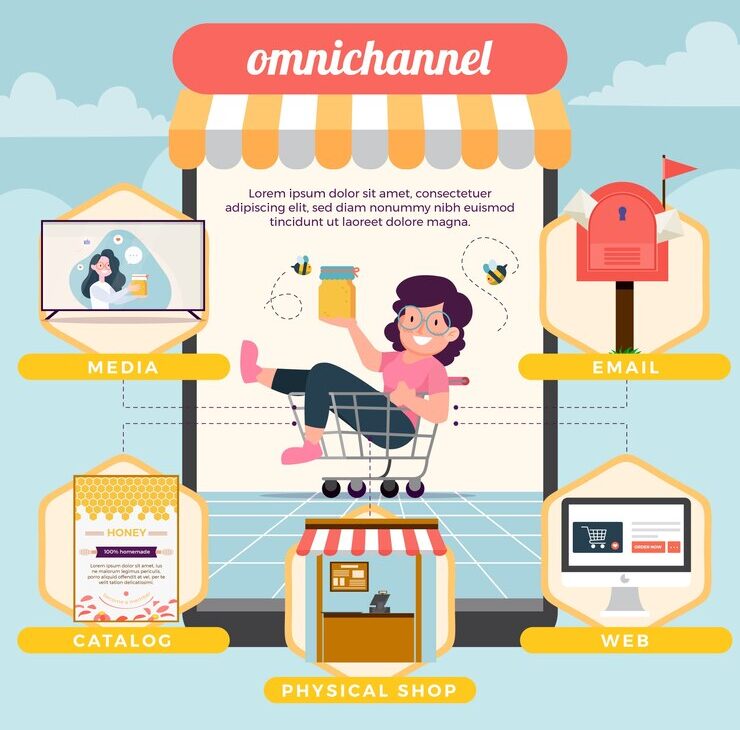The age of the digital revolution has ushered in an unparalleled change in how consumers shop and interact with retailers now. The rise of the internet and increasing smartphone penetration have given birth to a new retail phenomenon – Omnichannel eCommerce.
It has been hailed as the future of retail, transcending the barriers between online and offline spheres. This is due to its seamless, integrated approach to sales and marketing, which delivers shoppers a unified experience across online and offline channels at the right time while also aligning with current ecommerce trends.
Entwining the brick-and-mortar with online stores, encompassing eCommerce marketplaces, mobile applications, social marketing, email marketing and more, omnichannel commerce is all about providing the right customers multiple avenues to engage with your brand. In this blog, we will learn more about the Omnichannel Ecommerce concept in detail.
How Omnichannel Ecommerce Works?

Imagine the act of shopping being akin to navigating across various interconnected islands. Omnichannel commerce bridges these ‘islands,’ offering a unified shopping experience for customers. Be it ecommerce marketplaces, mobile applications, social marketing platforms, or even the metaverse, omnichannel commerce ensures consistency across all these platforms.
It brings together various elements like multichannel listing, point of sale (POS) integration, and inventory management into a single buyer’s journey. This means that when customers switch platforms or make additional purchases, their experience is not disrupted.
In other words, riding the waves and island-hopping (switching platforms) in the retail ocean becomes a smooth sailing adventure for customers with the help of Omnichannel Ecommerce.
What’s The Difference Between Omnichannel vs Multichannel Ecommerce?
In an ecommerce context, omnichannel and multichannel are distinct strategies with unique goals. Let’s briefly discuss the difference between the both.
Multichannel Ecommerce
Picture multichannel ecommerce as a theatre with distinct stages. Your business performs on each stage, engaging with the audience individually. However, there is no connection between these performances. Each stage or channel operates independently, catering to its audience demographic.
For example, one stage might have marketing promotions catered to a younger crowd, while another is designed for older demographics. Multichannel ecommerce maximizes your business reach by ensuring you’re present on as many stages or channels as possible without necessarily creating a connected experience across all the points.
Omnichannel Ecommerce
In contrast to multichannel ecommerce, omnichannel ecommerce can be seen as a single stage hosting a dynamic, interconnected performance. Located on different channels, the business ensures that these platforms collaborate to offer a consistent, unified customer experience. This strategy maintains harmony in the company’s messaging, branding, shopping experience, and pricing across all platforms.
Moreover, customer details across interactions are remembered, which facilitates a smooth customer journey. Hence, when a customer switches from one platform to another or makes additional purchases, the experience remains consistent and engaging.
What Are The Advantages of Omnichannel Ecommerce for Retailers
Investing in an Omnichannel ecommerce improves customer loyalty, creates a harmonious brand presence and image, enables personalized user experiences, and results in intelligent customer data usage through a more integrated approach. Let’s learn about the benefits of omnichannel e-commerce in detail.
1. Enhanced Customer Experience
One of the key advantages of omnichannel eCommerce is the enhanced customer experience it provides. It creates a seamless and consistent shopping experience across online, offline, and mobile platforms, catering to modern consumers who frequently switch channels. This approach ensures that interactions—whether in-store, on a website, or through a mobile app—are unified and harmonious for omnichannel customers.
Additionally, leveraging omnichannel data enables retailers to deliver personalized product recommendations and tailored offers, resulting in increased satisfaction and sales. This approach also smooths the shopping journey by maintaining consistent inventory and pricing across all platforms and offers adequate customer support, further strengthening customer relations.
2. Improved Brand Consistency
Consistent branding is essential for building customer trust and loyalty, and omnichannel commerce enables businesses to maintain a unified brand identity across all touchpoints. Whether in physical stores, eCommerce sites, social media, or mobile apps, customers encounter the same look, feel, tone, and messaging, fostering familiarity and emotional connections.
This brand consistency shapes customer perceptions and drives loyalty by creating a cohesive narrative that simplifies marketing strategies. A consistent omnichannel approach distinguishes your brand and supports long-term success in the competitive retail landscape.
3. Increased Sales and Revenue
Adopting an omnichannel eCommerce strategy significantly boosts sales and revenue. Studies show that customers engaging across multiple channels tend to make frequent purchases and spend more than those using a single channel. The seamless integration of online, offline, and mobile platforms creates convenient shopping experiences that enhance conversion rates.
Additionally, personalization from data collection leads to higher basket values by offering tailored product suggestions and encouraging additional purchases. This convenience also fosters customer retention and loyalty, driving repeat business. Ultimately, a well-executed omnichannel strategy acts as a catalyst for increased immediate and long-term sales revenue.
4. Streamlined Inventory Management
Successful inventory management is vital for a consistent omnichannel experience, and omnichannel commerce plays a key role in streamlining this process. It enables real-time inventory updates across all sales channels, ensuring accurate stock levels in physical stores, eCommerce sites, and marketplaces. The ‘endless aisle’ concept allows customers to order unavailable products online, preventing lost sales.
Furthermore, integrating online and offline inventories gives shoppers complete visibility into stock availability, reducing out-of-stock scenarios and enhancing satisfaction. Accurate demand forecasting based on omnichannel data helps businesses mitigate overstocking and waste. Overall, omnichannel commerce fosters efficient inventory utilization, creating a customer-focused inventory strategy.
How to Implement a Successful Omnichannel Strategy?
Efficient implementation of an omnichannel ecommerce strategy requires a cohesive approach, starting with understanding your customer journey. Let’s look into all these approaches in detail.

1. Understand Your Customer Journey
Understanding your customer’s journey begins with knowing their demographics, behaviors, and preferences. Map out the stages they commonly experience—such as awareness, consideration, purchase, and advocacy—while noting that journeys are rarely linear.
Aligning your communication and marketing strategies with each stage allows you to create targeted tactics that drive engagement, build trust, and encourage conversions to your target audience. A clear grasp of this journey forms the foundation for a successful omnichannel strategy.
2. Integrating Online and Offline Channels
Integrating online and offline channels is essential for a seamless omnichannel shopping experience, as customers frequently move between digital and physical touchpoints, including various social media platforms. Consistent branding—such as unified visuals, messaging, promotions, and pricing—is key to achieving this.
Real-time inventory updates help avoid stock discrepancies between online and in-store availability. Cross-channel services like ‘Buy Online, Pick Up in Store’ (BOPIS) and ‘Buy Online, Return in Store’ (BORIS) enhance convenience. Finally, integrating data across channels enables personalized interactions based on customers’ overall shopping behaviors, further enriching the experience.
3. Data-Driven Personalization
Personalization is key in an omnichannel strategy, allowing retailers to use data like purchase history and browsing habits to enhance customer engagement and experiences. By applying insights from analytics, businesses can send relevant recommendations and reminders, such as emails for abandoned carts or product suggestions based on past visits.
This tailored approach across all channels boosts customer satisfaction, drives loyalty, and increases sales, thereby helping to drive sales by engaging customers at just the right moments.
4. Unified Inventory Management Solutions
Efficient inventory management is essential for a seamless omnichannel strategy. By implementing real-time tracking, businesses ensure accurate stock information across all channels, reducing out-of-stock issues. Automated re-ordering helps maintain optimal inventory levels, avoiding overstock and stockouts.
A centralized inventory system keeps data consistent and accessible, while demand forecasting based on past sales data enables better preparation for high-demand periods. Together, these elements streamline supply chain operations and enhance the customer experience across all channels.
5. Embracing Mobile Optimization
Mobile optimization is essential for any omnichannel strategy in today’s smartphone-driven world. This means creating a responsive, fast, and user-friendly experience for mobile shoppers, with streamlined navigation and checkout. Mobile-specific incentives, such as app-exclusive features or promotions, can further engage users.
Leveraging mobile data allows retailers to personalize experiences based on location and usage patterns. By prioritizing mobile, retailers ensure their omnichannel strategy aligns with the core of modern shopping habits.
6. Leveraging Automation Across Channels
Automation is key to a successful omnichannel business strategy, streamlining processes across marketing, inventory, customer support, and data analysis to maintain a consistent brand experience. Automated emails can deliver timely, personalized messages like cart reminders, while inventory automation provides real-time stock updates and triggers re-orders as needed.
Chatbots enhance customer service with 24/7 support, and automated data analysis offers insights into sales and customer behavior. Businesses improve efficiency, responsiveness, and the overall shopping experience through automation, strengthening their omnichannel effectiveness.
What Are the Challenges and Considerations for Omnichannel Ecommerce?
While beneficial, implementing an omnichannel eCommerce approach comes with its unique set of challenges. Let’s quickly have a look at them.
1. Technology Integration
Integrating multiple platforms and technologies is perhaps the most significant challenge in implementing an omnichannel strategy.
Here are some techniques to alleviate this challenge:
- Unified Platform: Implement an eCommerce platform capable of supporting all your sales channels, ensuring seamless integration and consistency.
- API Integration: Use API integrations to ensure different platforms talk to each other effectively, making data sharing possible across all channels.
- Real-Time Sync: Make sure your systems can sync in real time, updating inventories, prices, and other related information across channels instantly.
- Secured Transactions: Ensure that your technology stack can process and store customer data securely, maintaining the integrity of transactions across all channels.
2. Consistent Customer Experience Across Channels
Providing a consistent Omnichannel customer experience is a key challenge in omnichannel eCommerce.
Here are some techniques to overcome this challenge:
- Consistent Branding: Ensure cohesive brand visuals, messaging, and shopping experience across all channels, including website, mobile app, and physical stores.
- Unified Customer Data: Use a single view of customer data to personalize interactions across platforms, ensuring tailored, relevant experiences.
- Real-Time Inventory Visibility: Keep inventory updates in sync across all channels to avoid stock discrepancies and enhance the shopping experience.
- Integrated Customer Service: Provide seamless, responsive support that bridges online and offline experiences, ensuring customer needs are met no matter where they engage.
3. Managing Logistics and Fulfillment
Managing logistics and fulfillment efficiently can present challenges under an omnichannel strategy.
Here are some solutions:
- Centralized Fulfillment: Have a centralized system for managing orders from all channels, ensuring swift and accurate dispatch.
- Integrated Logistics: Work with logistics partners capable of integrating systems so shipment tracking and updating are automatic and real-time.
- Flexible Delivery Options: Provide multiple delivery options like in-store pickup, home delivery, or third-party collection points catering to customer convenience.
- Seamless Returns: The returns process should be seamless—allowing online returns in-store or easy return shipping.
4. Addressing Data Privacy Concerns
In an omnichannel approach, businesses collect vast customer data across various touchpoints. While this data is crucial for personalizing the customer experience, it also presents significant concerns regarding data privacy and protection.
Here are ways to solve it:
- Regulatory Compliance: Adhere to data protection regulations such as GDPR or CCPA, ensuring all practices align with regional laws.
- Explicit Consent: Collect clear and informed consent from customers regarding data collection and usage.
- Secure Data Management: Implement strong security measures and regularly audit data protocols to protect customer information.
- Customer Control: Provide customers with easy access to their data, allowing them to modify or delete information as needed, thereby fostering trust and transparency.
Conclusion: The Future of Retail Lies in Omnichannel Ecommerce
Omnichannel commerce is rewriting the retail playbook to the tune of digital evolution. As customers’ shopping habits evolve, so must retailers’ strategies. Adopting an omnichannel ecommerce strategy provides a seamless experience for customers, allowing them to navigate effortlessly between channels. This cohesive journey enhances user satisfaction and fosters brand loyalty.
To succeed, businesses must leverage customer data effectively, ensure consistent experiences, and maintain robust customer support while addressing challenges like inventory discrepancies. By embracing this approach, businesses can better meet customer needs and unlock the potential of the evolving retail landscape. A pro tip we would like to provide here is to upload FlixStudio‘s world-class ecommerce photographs on all the platforms as a part of your Omnichannel ecommerce strategy and get top-notch results.
Frequently Asked Questions
What is omnichannel e-commerce?
Omnichannel eCommerce is an approach to sales that integrates various channels—like physical stores, online marketplaces, and mobile—to provide customers with a consistent and cohesive shopping experience, no matter how or where they choose to shop.
How does omnichannel retailing differ from multichannel ecommerce?
While both omnichannel and multichannel eCommerce involve operating across multiple sales channels, the key difference lies in their level of integration. Omnichannel retailing ensures a fully integrated and seamless customer experience across all channels, whereas multichannel retailing may operate channels independently, leading to a less cohesive customer journey.
What are the potential challenges of implementing an omnichannel ecommerce strategy?
Deployment of an omnichannel strategy may present challenges such as integrating technology across different platforms, providing a consistent experience throughout, efficiently managing logistics and order fulfillment, and addressing data privacy concerns—all while ensuring seamless operations to deliver enhanced customer experiences.
How can I create an effective omnichannel strategy for my retail business?
Creating an effective omnichannel strategy involves understanding your customer’s journey, integrating online and offline channels, personalizing the customer experience based on data, optimizing inventory management across channels, embracing mobile optimization, and leveraging automation tools for efficient operations across channels.
What makes omnichannel ecommerce superior to traditional ecommerce methods?
Unlike traditional methods restricting customers to a single channel, omnichannel eCommerce studies customer behavior across various touchpoints to create seamless, integrated online shopping experiences. It provides increased convenience, personalization, and real-time updates and maintains brand consistency, making it a robust approach compared to conventional eCommerce.



